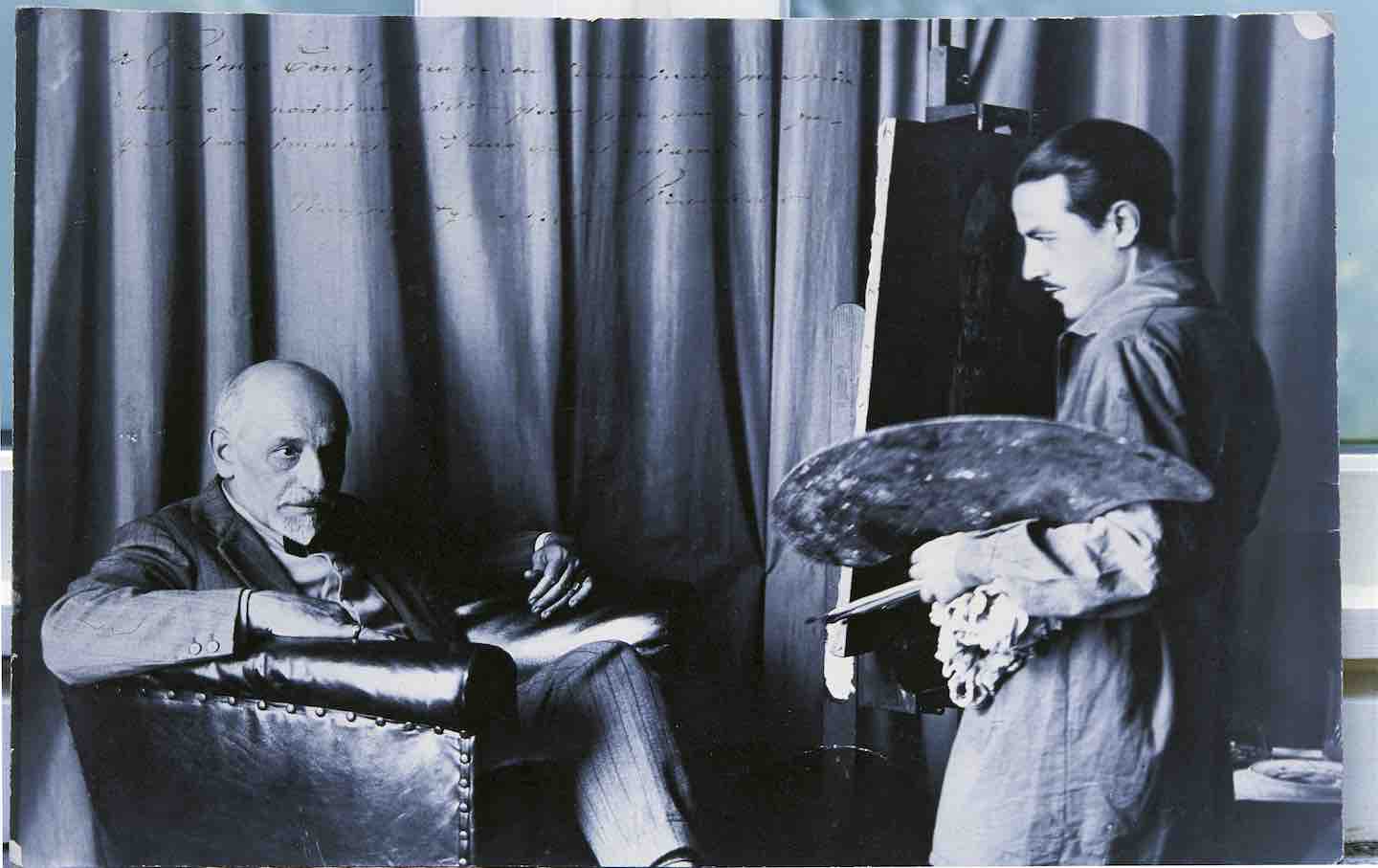Optical Illusions
What was digital media?
What Was Digital Media?
Ben Smith’s Traffic charts the boom and bust of a new age of online journalism.

The most interesting thing you will learn from Ben Smith’s Traffic: Genius, Rivalry, and Delusion in the Billion-Dollar Race to Go Viral is that Jonah Peretti, Smith’s former boss at BuzzFeed, once possessed the ability to dunk a basketball. The second-most-interesting thing you will learn is that one of Smith’s proudest achievements as the editor of BuzzFeed was the day of The Dress.
You might remember the warmed-over meme: an image of an ugly striped dress that some people saw as black and blue and others as white and gold. It was a trick of the light, the glare of an optical illusion, that Smith claims furnished his world-historical contribution to humanity—“the last, greatest, totally harmless moment of global internet culture.” It’s all gone downhill from there.
Books in review
Traffic: Genius, Rivalry, and Delusion in the Billion-Dollar Race to Go Viral
Buy this bookSmith spends an entire chapter of Traffic on The Dress. For him, that day was not just one of the most important moments in his life as a journalist; it also helps explain what BuzzFeed could provide its putative readers. “The Dress was universal,” Smith explains, “a form of media that didn’t even require literacy to land.” The illiterate, the unwashed, and the vulgar could all enjoy BuzzFeed: If you scrolled through its pages long enough, the website promised, delight was just around the corner. “Within a couple of hours,” he writes, “traffic rose to seven hundred thousand people simultaneously, seven times our usual peaks.”
The backstory that Smith unspools about the day of The Dress is pretty banal. It involves a BuzzFeed employee’s efforts to turn a query from a Scottish person at a wedding into a BuzzFeed quiz. The year was 2015, and BuzzFeed had just been valued at $850 million. The company’s trend lines seemed to point toward unicorn status, a billion-dollar company built on the back of quizzes, listicles, and memes. The lucre it harvested from all those eyeballs trained on the site showed the public that BuzzFeed was a digital media force to be reckoned with. It promised to make the news fun.
Among the many tired arguments that Smith returns to time and time again in Traffic is his notion that the ideal news consumer—college-educated, works in an office, active on social media—couldn’t care less about serious topics. The sort of story that might captivate this ideal news consumer is precisely something like The Dress. This is not to say that Smith didn’t run a serious news operation every now and then (and broke news on things like the Steele dossier), but he believed that what he did as a serious news editor was subsidized by all the attention paid to the stunts: blowing up a watermelon with rubber bands, videos of millennials eating caviar and rare truffles, and so on.
This unseemly bargain sits at the center of Traffic, which examines the rise of BuzzFeed as well as that of three rival media organizations—Gawker, The Huffington Post, and Breitbart—from the early 2000s to the end of the 2010s. Each of these four understood what legacy media companies like The New York Times and Conde Nast did not (yet): that attention online could be its own form of profit.
Today BuzzFeed is reported to be valued at around $86 million. The news division that Smith once led is gone. Meanwhile, Gawker has been shuttered twice—the first time after a Peter Thiel–backed lawsuit and the second after a brief revival by a fratty media entrepreneur named Bryan Goldberg. A leaner version of The Huffington Post, now called HuffPost, is still kicking around, but it’s owned by BuzzFeed after being dumped by AOL and Verizon. Breitbart, once seen as the most dangerous media organization on the right, has become a smaller fish in a far larger pond of conservative commentary. The era of The Dress is over. What it said about the Internet as a freewheeling marketplace of ideas and pleasures is gone too.
What even is “traffic”? Smith provides an easy-to-understand definition before the drama of his book unfolds: Traffic is “literally, just the record of the request your desktop computer made of the computer hosting the article you were reading.” It’s a metric that indicates when someone is looking at the article you just posted. So what makes traffic anything more than simply a document of someone’s passing attention? Well, if you’re reading this article on The Nation’s website, it counts toward our traffic numbers, which benefits us through a CPM deal that our magazine has brokered with advertisers. What is CPM? It stands for “cost per mille” (or “thousand,” if you don’t speak French), which is a set fee that advertisers pay publishers per every 1,000 views on any given article or piece of content that hosts ad space. Traffic, in other words, is one way publishers can make money on the Internet.
Even as a young graduate-school dork, Jonah Peretti was obsessed with traffic. He was “among the first to discover, it wasn’t merely mechanical,” Smith writes. “Traffic was human emotion, human psychology, desire and curiosity and humor.” Traffic was not just a number to Peretti, but a natural resource that could be mined and refined through spectacle. The itch to go viral for Peretti started at the MIT Media Lab, where an act of shitposting made him briefly famous. One day, he tried to buy a pair of customized Nikes that had the word “sweatshop” emblazoned on them, but Nike blocked the purchase of the personalized shoes. Peretti’s e-mail exchange with a customer service representative about the incident was funny, absurd, and salty enough that it was posted on a friend’s blog (after it was turned down by Harper’s) and then whipped its way around the early-2000s Internet. Somehow, Peretti found himself talking to Katie Couric on morning television to defend his prank to the public: He wanted to raise awareness about labor conditions, of course.
“Jonah sought to draw broader lessons from his experience,” Smith tells us. He felt that one could turn all that vaporous, unrefined attention into something more concrete—maybe not into social change, but at least into power, influence, and money. His grad-school classmate Cameron Marlow thought Peretti was crazy: Marlow “saw a profound randomness to the power of these new digital social networks,” Smith writes, “and thought it would be impossible to rig them or control them, to replicate your past success.” Before they left Massachusetts for New York City, the pair made a bet (for $2) that Peretti could not “re-create his success, systematize it, bottle it up.”
One could argue that Peretti has won that bet a billion times over by this point: He followed up his Nike stunt with another called “Black People Love Us,” a trolling humor site that spotlighted a (fake) white liberal couple who bragged about their ability to make Black friends. The website—coauthored with his sister, the comedian Chelsea Peretti—garnered more traffic than some of BuzzFeed’s future competitors, like Gizmodo. Peretti’s antics brought him into the orbit of Kenny Lerer, an entrepreneur who’d made a fortune at AOL before the bubble burst, and Arianna Huffington, the socialite journalist and reformed “Republican Spice Girl.” Bored and rich, and Democratic Party boosters to boot, the pair shared a lurid fascination with the Drudge Report and wanted to replicate its success.
Their simple idea was to create a news site, named after Huffington, that would be both respectable and cutting-edge, friendly to the Beltway and the Democratic Party as well as enticing to the masses of early Web 2.0. They asked Peretti to join them as their designated tech guy and recruited the likes of John Cusack and Arthur Schlesinger Jr. to “blog” for them in their efforts to keep up with the times.
Lerer and Huffington may have had partisan ambitions, but they weren’t picky about whom they worked with. They recruited Andrew Breitbart, Matt Drudge’s secret collaborator and the guy who managed the Drudge Report’s homepage, to help, and while he didn’t last long at The Huffington Post, he did go on to launch his own site, Breitbart News, which was the exact opposite of HuffPo in every way except one: Both websites saw their audience as something more (and less) than readers; they were “traffic” that could be channeled “into action.”
Just as The Huffington Post and Breitbart News were getting off the ground, Nick Denton was busy making fun of everyone involved. In another life, Denton had been a business journalist for the Financial Times who covered the tech industry in San Francisco in the late ’90s. Before the dot-com bubble burst, he left journalism and cosplayed as a “founder,” starting an early social media company for techies called First Tuesday and then a media aggregator called Moreover. He landed in New York in the early 2000s and eventually received a sizable payout when Moreover was sold. The first thing he did was start a blog, and with the help of other local bloggers he hired, he began a mini-empire whose crown jewel was the gossip and news website Gawker, which would pioneer a new, pithier, and more personal mode of Internet writing.
In Smith’s telling, Denton is a foil to Peretti: cool, gay, British, mean, and fun. He throws great parties at his loft in Soho; he is already rich and refuses venture capital; he is an artist when it comes to traffic, whereas Jonah is more a scientist. Serving as the resident tech bro at The Huffington Post (and, crucially, not as an editor), Peretti “wasn’t concerned with taste or quality or brand or consistency. He just wanted to know what would get traffic.” His editorial vision, to the extent that one existed, was yoked to the pranks and spectacles that had made his name, which spoke to his overriding fixation: “how to make a single idea—often, a single joke—travel, regardless of its content or the identity of the person who originated it.”
Gawker, on the other hand, became defined by a far grander argument—that one could, Smith writes, “merge the insights of technology with the social connections of media, all in the service of getting at that elusive commodity, the truth.” Smith declines to say what this actually means, but Denton’s coveting of “the truth” might be translated into a blunter observation about what people read: He liked to air dirty laundry (of elites and even of his staff), and his websites, for better or worse, were defined by a relentless, vicious, and often memoiristic form of journalism—so mean, pointed, and personal that it was impossible to look away.
Gawker wasn’t Denton’s first website (Gizmodo was), but it provided the blueprint for his empire, which encompassed Deadspin, Jezebel, and myriad others. One of the most curious chapters of Smith’s book is about the founding of Jezebel, helmed by Anna Holmes. If The Huffington Post and Breitbart News were harbingers of the political polarization of the media, Smith argues, Jezebel was the beginning of online identity politics and, although he doesn’t exactly say it outright, cancel culture. He credits the style Jezebel invented—personal, explicitly political, quippy—and its planks of coverage (sex, the workplace, and how dumb women’s magazines were) as a “new kind of cultural politics that would reshape America when social media really came of age.” Reading statements like these, the reader might wonder if Smith was literate before the Internet: The feminist-inflected journalism that apparently terrifies him—because of its conviction and emotion—was not Jezebel’s alone. It was developed years before that in alternative weeklies like The Village Voice and more women-focused magazines like Sassy and Ms. Still, for Smith, Jezebel assumed an outsize role in what was to come: “If you squint at 2007 Jezebel,” he writes, “you can see 2020s Twitter more clearly than anywhere else on the internet of that era.”
What does it mean to depict your competitors and predecessors as horsemen of the social media apocalypse? And where does Smith fit into this story? He doesn’t appear in person until the middle of the book, right before he joins BuzzFeed and is toiling away as a reporter at Politico. But once he enters the stage, the book takes on a newly (and unintentionally) entertaining and gossipy quality. BuzzFeed, he tells us, grew out of what he calls a “skunk works” for The Huffington Post, a place where Peretti tinkered with formulas to draw traffic to his employer’s more moribund areas of coverage (all those John Cusack blog posts). What Peretti discovered during all of this R&D was what we now call “clickbait”—sensational content, be it the promise of nudity or scandal, that we can’t help but click on, juicing a website’s traffic through the process of engineered rubbernecking.
BuzzFeed became its own entity in 2006 as a sort of lab that analyzed traffic on the Internet. It originally had no editors or writers and was merely, according to Andrew Rice at New York, “an algorithm to cull stories from around the web that were showing stirrings of virality.” For years, Peretti split his time between The Huffington Post and BuzzFeed. But when HuffPo was bought by AOL in 2011, Peretti left to run BuzzFeed full time, decamping to its Chinatown office and adding more humans to the mix. Among his first hires were Internet-obsessed millennials, such as Peggy Wang, the site’s earliest editorial employee (who is better known as a member of the band the Pains of Being Pure at Heart), and Christopher Poole, who founded 4chan.
Popular
“swipe left below to view more authors”Swipe →At first, journalism was the farthest thing from Peretti’s mind. The office politics and actual politics of a place like The Huffington Post had grated on him, and he wanted to prove that you could direct the sheeple of the Internet to any car crash you wanted. But eventually Lerer, a partner in BuzzFeed’s early days, convinced Peretti that a news division would make outside observers take his business more seriously, and so he hired Smith. What follows reads, in retrospect, almost like a blind date: a lunch at a downtown hot spot, a walk in the park, a will-they-or-won’t-they? Smith paints himself in somewhat contradictory terms as he enters the frame: He’s an aw-shucks sort of guy, not cool or edgy enough to swim in the waters with the sharks at Gawker, but ambitious and ruthless all the same, hungry for the spotlight and ready to make his name.
The Smith and Peretti meet-cute is mostly self-serving but occasionally candid: Smith describes how BuzzFeed outflanked traditional outlets during the 2012 election and how he helped build a newsroom stocked with similarly hungry go-getters and some expats from the tonier warrens of journalism. He offers up a few apologies, too: for hiring right-wing troll Benny Johnson to be BuzzFeed’s version of David Brooks, and for the bad business advice he gave Peretti—vetoing a possible sale to Disney in 2014 that would have given both of them a golden parachute—while smoking a joint in a hotel room. (He really wants you to know that he inhaled.)
For all the clichés strewn throughout these sections of the book, the level of detail Smith supplies is admirable, and his sense of digital media’s blind spots is prescient. For example, he says he saw early on that legacy media institutions like The New York Times would overtake BuzzFeed once they were comfortable with adapting to journalism as it existed online, because they were name brands that could parlay traffic into a sizable subscription business. But the book never deviates from the willful arrogance that defines it from the start: the idea of the news consumer as a fundamentally stupid person. As Denton says, and as Smith constantly reiterates, their readers were “bored office workers [who] weren’t clicking around looking for articles about inequality.”
By the end of Traffic, Smith has begun to wonder whether Peretti lost his bet with Cameron Marlow after all. Maybe the Internet is a place that is too chaotic, too hospitable to reaction and anger, to be controlled in any meaningful way. Places like Gawker, Jezebel, The Huffington Post, and Breitbart News, he argues, all supercharged the free-floating vitriol of the Internet. Noticeably, he does not include BuzzFeed on this list, which allows him to avoid his own complicity in publishing dreck, but it also sidesteps another uncomfortable question that remains unasked in Traffic: How much influence do journalists and media organizations really have? Can they actually shape reality in the way that Smith seems to think they can? Or is the news—especially digital media—just a bad business? Instead of answering any of these questions, Smith avoids them altogether and spends the book’s last chapters recounting Peretti’s and the company’s missteps before Smith found greener pastures, walking away from the impending implosion relatively unscathed.
All of this brings us to the third- most-interesting thing you will learn from Traffic, a hard truth that Smith either sees and won’t comment on or is too nostalgic to admit: Even when these digital media properties were dominant, the new way of doing business that he and his peers championed made journalism a far shittier profession—one hopelessly fixated on the whims of social media and venture capital.
The success of The Dress, and other digital media spectacles like it, Smith argues, set off a series of algorithm changes at Facebook, which eventually targeted news organizations in a 2018 change. As a website that relied on traffic mined from social media, BuzzFeed was greatly hampered by these changes, and the fortunes of the onetime unicorn began to wane and layoffs soon followed.
Before storm clouds seemed ready to engulf everything, Smith found an exit and joined The New York Times as its media columnist. Only two years later, he left the Times to start a new media venture called Semafor, whose target audience is “200 million members of an ‘English-speaking, college-educated, professional class.’”
How Smith and Semafor came up with that number is puzzling, but even to set your sights on such a hazy demographic speaks to the basic thing that makes Smith such a bad media critic: the notion that all it takes is someone like him, or Peretti, or Denton, to get the bored office worker to start paying attention to some dazzling new thing. Meanwhile, BuzzFeed’s fortunes reached their nadir this year with the decimation of the company’s news division and a new pivot to AI. Peretti’s latest venture within the BuzzFeed universe is called Botatouille, an AI-powered app that recommends recipes.
In the final pages of Traffic, Smith acknowledges that journalism is facing a dire future: “Those of us who work in media, politics, and technology are largely concerned now with figuring how to hold these failing institutions together or to build new ones that are resistant to the forces we helped unleash.” For the average worker in these fields—media, politics, and tech—the question of how to hold together failing institutions or build new ones fails to address a more immediate concern: the very conditions these workers are forced to labor under.
Like so many forms of labor in the United States, the broad category of work that falls under the heading of journalism today, whether it be blogging, editing, reporting, criticism, podcasts, or anything in between, is beset by something that journalists have no control or influence over. In a market where unending growth is demanded and where cheap and unprotected labor is coveted, it can be hard to do anything rigorous or creative or time- and resource-intensive. No matter your role in this broken ecosystem, you will find it necessary to chase what worked yesterday, what you think will give you a quick reader or a quick buck today. But without an overarching strategy or plan, it is impossible to build lasting institutions. Only the giant media entities of the world can take risks and play the long game.
For journalists, traffic might be a metric that rules our lives in this shortsighted age, even as we all know that it has become less and less valuable (nowadays, those CPM deals matter a lot less than subscription numbers). Union drives have been one way to ensure some amount of job security, but as proved to be the case with the BuzzFeed News union, a contract that one successfully fought for might only partially sweeten the bitter pill—in this case, that journalists are working in a system that ultimately sees them as disposable.
Disobey authoritarians, support The Nation
Over the past year you’ve read Nation writers like Elie Mystal, Kaveh Akbar, John Nichols, Joan Walsh, Bryce Covert, Dave Zirin, Jeet Heer, Michael T. Klare, Katha Pollitt, Amy Littlefield, Gregg Gonsalves, and Sasha Abramsky take on the Trump family’s corruption, set the record straight about Robert F. Kennedy Jr.’s catastrophic Make America Healthy Again movement, survey the fallout and human cost of the DOGE wrecking ball, anticipate the Supreme Court’s dangerous antidemocratic rulings, and amplify successful tactics of resistance on the streets and in Congress.
We publish these stories because when members of our communities are being abducted, household debt is climbing, and AI data centers are causing water and electricity shortages, we have a duty as journalists to do all we can to inform the public.
In 2026, our aim is to do more than ever before—but we need your support to make that happen.
Through December 31, a generous donor will match all donations up to $75,000. That means that your contribution will be doubled, dollar for dollar. If we hit the full match, we’ll be starting 2026 with $150,000 to invest in the stories that impact real people’s lives—the kinds of stories that billionaire-owned, corporate-backed outlets aren’t covering.
With your support, our team will publish major stories that the president and his allies won’t want you to read. We’ll cover the emerging military-tech industrial complex and matters of war, peace, and surveillance, as well as the affordability crisis, hunger, housing, healthcare, the environment, attacks on reproductive rights, and much more. At the same time, we’ll imagine alternatives to Trumpian rule and uplift efforts to create a better world, here and now.
While your gift has twice the impact, I’m asking you to support The Nation with a donation today. You’ll empower the journalists, editors, and fact-checkers best equipped to hold this authoritarian administration to account.
I hope you won’t miss this moment—donate to The Nation today.
Onward,
Katrina vanden Heuvel
Editor and publisher, The Nation









